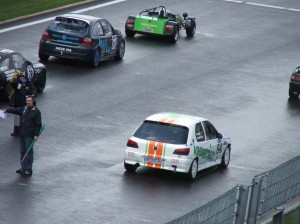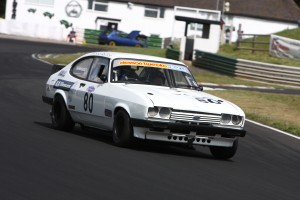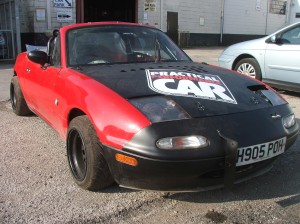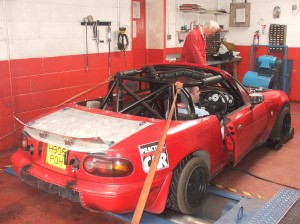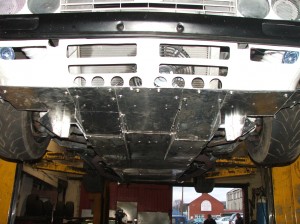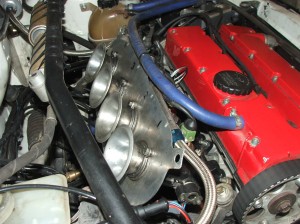In between jobs we’ve been working on some new manifolds for our Capri Race car. Proper exhaust manifolds take a long time to make but there’s a lot of calculations to make before the welding begins. Race manifolds need to take into account all sorts of details about the design of the engine, head, valves, cams and even the gear ratio’s and rolling road power plot. Once all of that is taken into consideration the work can begin. You can see from the picture how much is involved with getting so much tube wrapped around the engine bay. The power gains are well worth it though.
Archive for the ‘Race news’ Category
Capri Exhaust manifolds
Friday, October 5th, 2012Schumacher drops in
Tuesday, August 14th, 2012Michael Schumacher dropped by with his F1 car recently so we could give it a service and do the tracking. We Wish! This is our F1 simulator and show car which is normally out and about at shows. the transporter had to go for repairs so the car lived in the corner of the garage for a few days. It just looks so cool we had to put a picture of it on the blog.
Capri Development
Tuesday, August 14th, 2012The AA Sport/AA Silencers Capri race car continues to be developed in between other commitments. The latest development is with the rear axle location. These bars reduce both axle tramp and lateral movement. An added advantage is that by moving the pickup points we’ve been able to change the roll axis of the car and hopefully improve the handling. More testing is required but it looks good so far
MX5 at the rolling road
Tuesday, August 14th, 2012It’s what we do- excerpt from an article for Practical Performance Car magazine
Friday, April 27th, 2012It’s strange that the first question people ask when they’re checking out modified cars is often ‘How much power has it got?’ It’s all well and good being able to say it’s got 400 bhp, but how much weight is that power having to shift? If the car weighs two tonnes then you’ve only got 200 bhp per tonne, which is suddenly less impressive. That’s only equal to a 100 bhp engine in a 500 kg car. The thing is if you tell people you’ve only got 100 bhp they’ll snigger and walk away. ‘Pfff, my Mom’s Corsa has got more power than that’. The conversation’s over before anyone mentions weight.
Weight goes far beyond the simple bhp/tonne figure though. Bigger engines will often produce more than enough power to compensate for their extra weight. Carrying a hoofing great engine around does nothing for the handling though. The overall weight of a car will make a huge difference to how it accelerates, brakes and turns into a corner. The distribution of the weight in the car is just as important and can be used to either tune or ruin the handling characteristics.
It’s fairly obvious that having a light car means you can accelerate and brake faster, there’s less weight to move around. But just as important is how the weight is spread out across the cars tyres. Each tyre is actually holding up a different weight. In most road cars with the engine up front, the front tyres are holding up a lot more weight than the rears. Likewise with only the driver in, the off side tyres are carrying more weight than the nearside. Amongst other things, the amount of weight (or down force) a tyre has on it will dictate how much grip it can produce, up to a point. From that you could think a heavier car could corner faster. The problem is that the cars weight also acts sideways in a corner and it takes some of the available grip of the tyre and pulls it sideways, causing the tyre to ‘scrub‘. All tyres scrub sideways when turning, it’s known as the slip angle. Push the slip angle too far and you’re sliding, push the slide too far and you’re spinning. Heavier cars increase slip angles faster than light ones so they run out of grip faster.
To help ensure each tyre is carrying an equal load to start with, cars can be corner weighted. That involves raising the spring heights so more load goes onto the corners where there was less. Unless you have a very well balanced car the weight distribution will always be biased in one direction or another, but it helps to spread the cars weight as evenly as possible. This means each tyre is doing it’s fair share of clinging your car to the road. Corner weighting a car doesn’t necessarily move the weight distribution in the car, it just alters how the car’s suspension supports it.
Of course all that talk of spreading the weight out on the tyres is massively over simplified. There’s so many other factors influencing how the car’s suspension behaves, and all we’ve considered so far is how the weight is supported across the four corners. We should also spare a thought for where the weight is in the car. Rather than just say the car has weight, the weight distribution around the car can all be added up and said to have a centre of gravity. It’s basically the balance point for all the weight in the car. If the car was hung from a rope attached at the centre of gravity it would always be balanced. The centre of gravity also has a height within the car. The higher the centre of gravity the more a car will lean as it corners. It leans, or rolls because opposing forces act on the centre of gravity as you corner. It’s those forces you can feel when you are pushed out of your seat as the car brakes or corners. This is called weight transfer. The more it rolls during a corner the more it takes load off the inside tyres reducing the overall grip available to the car.
The centre of gravity rolls around a pivot point called its roll centre, which is set by the cars suspension pick up points. Unless you’re planning on moving the suspension pick up points the best way to reduce the amount of roll a car has is make it lighter and get the weight as low down in the car as possible. Stiffer suspension springs will resist body roll. Generally you’ll always want the softest springs possible for traction but stiff enough to stop too much weight transfer. Assuming your tyres are up to the job of transmitting the load then sometimes a bit more weight transfer in a straight line (pitch) helps push them into the road surface and get more grip. For example if you have a rear wheel drive car with the engine at the front you’ll need a bit of weight transfer to get the driving tyres to grip properly. Generally though too much weight transfer reduces grip and ruins the balance in the car, especially during cornering (roll). It’s that balance that everyone’s trying to find when they set a car up. How much weight your car has and where it’s distributed will affect how much weight transfer you have, how much work your suspension is having to do and so how hard you can push your tyres when accelerating, braking and cornering. Performance driving techniques are all developed around shifting the balance around the tyres to get the best grip for the longest time. It’s all of these factors and more that we focus on when developing a car, and it’s driver.
MX5 Hillclimb car
Friday, April 27th, 2012 We’ve been building this hillclimb car for Practical Performance Car Magazine. The full details of the build will be available to read over the next few months. PPC mag have an event called the 999 challenge. The idea is to build the best MoT passable car you can for 999 quid and carry out a timed quarter mile and handling course. The fastest car wins. We decided to take the concept a step further and see if we could build a hill climb car for full competition still sticking to the 999 pound budget. The list of modifications is massive. We reduced the weight by about 20% which is hard going on a car that’s so light to start with. With all the weight stripped out we built a cage that not only keeps the driver safe but adds to the shells rigidity. The engine received a turbo and anti lag system including launch control and flat shift. It also features a hydrogen gas system for better combustion and a cold water spray for the intercooler. We carried out a few suspension and brake modifications and thoroughly set the cars geometry to give it perfect handling. The aerodynamics were last to be addressed and are controlled tightly by the regulations. We designed an aero package that other than the allowed rear spoiler didn’t change the cars silhouette. We achieved this with a flat underfloor, undercut splitter and a rear diffuser than uses a cut out into the rear bumper. The rear aero is fed by the exhaust gases between the spoiler and the diffuser which aid flow attachment. There’s still some fine tuning to be done but it should be an awesome package on a very tight budget
We’ve been building this hillclimb car for Practical Performance Car Magazine. The full details of the build will be available to read over the next few months. PPC mag have an event called the 999 challenge. The idea is to build the best MoT passable car you can for 999 quid and carry out a timed quarter mile and handling course. The fastest car wins. We decided to take the concept a step further and see if we could build a hill climb car for full competition still sticking to the 999 pound budget. The list of modifications is massive. We reduced the weight by about 20% which is hard going on a car that’s so light to start with. With all the weight stripped out we built a cage that not only keeps the driver safe but adds to the shells rigidity. The engine received a turbo and anti lag system including launch control and flat shift. It also features a hydrogen gas system for better combustion and a cold water spray for the intercooler. We carried out a few suspension and brake modifications and thoroughly set the cars geometry to give it perfect handling. The aerodynamics were last to be addressed and are controlled tightly by the regulations. We designed an aero package that other than the allowed rear spoiler didn’t change the cars silhouette. We achieved this with a flat underfloor, undercut splitter and a rear diffuser than uses a cut out into the rear bumper. The rear aero is fed by the exhaust gases between the spoiler and the diffuser which aid flow attachment. There’s still some fine tuning to be done but it should be an awesome package on a very tight budget
Ford Capri gets more aerodynamics
Friday, April 27th, 2012The AA Silencers Ford Capri is always getting little developments here and there. Because of a change in championship regulations we have been able to develop a new front splitter and diffuser. The device is designed to control the airflow to the under body section. The splitter harvests pressure ahead of the car to create downforce. Further back air is accelerated to create downforce towards the middle of the car. The new front section controls the air in stages to manage its flow. It is also designed to create vortices along the underbody to seal the floor section and improve downforce. It’s not a perfect design as we have to work within the regulations but it vastly improves lap times. Also fitted are a type of dive plane in front of the rear wheel. Unlike regular dive planes these are mostly to deflect air from the exposed portion of the the tyre.
More Porsche engines
Tuesday, November 29th, 2011A regular customer of ours runs this 924 carrera GT in the MSVR championship. He was due to race on a Saturday so opted for a quick test session the Wednesday before. The car arrived with us on Wednesday afternoon with an odd misfire and an hour later we had found a hole in one of the pistons. Not wanting him to miss out on any racing we set about stripping the engine down. By Friday lunchtime the car was running again and he made it to the race on Saturday.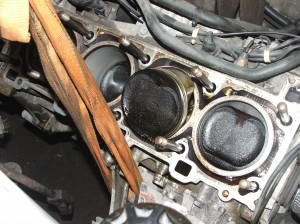

Missing misfire
Thursday, September 8th, 2011This Astra race car came to us with a misfire that only occurs after half an hour or so of running on the race track. We did a few checks and a bit of digging around. The ECU is a Canems which we use quite a lot of. After running a little data logging and looking at the program it showed the injectors were running beyond their duty cycle and some temperature corrections seemed a little odd. We changed the whole throttle body assembly for one with bigger injectors and the car was remapped to suit. So far it looks as though the problem is solved.
CSCC from Spa, Belgium
Friday, July 1st, 2011For the third round of the season we travelled to Belgium. Spa is a long time fixture on the Formula one calendar and an awesome circuit. Corners such as Eau Rouge and Blanchimont require so much accuracy, skill and bravery. The whole lap is a breath taking rollercoaster. On the thursday test we carried out a few minor changes which set the car perfectly for the circuit. In qualifying the rain came along but that had little effect on our pace, with the car once again finding itself on class pole. My co driver and car owner took the start but on the run to Eau Rouge dropped a couple of places with a missed gear. Trying to slot back into the pack he ran slightly wide on the exit and the rear wheel hooked the damp exit kerb pitching the car into a spin. Most of the pack avoided the spinning car but a Westfield also ran wide and hit the back of the Pug, now stationary on the grass. The result was the Peugeot was for the second time this year running on 3 wheels, and the race would go no further for us. 